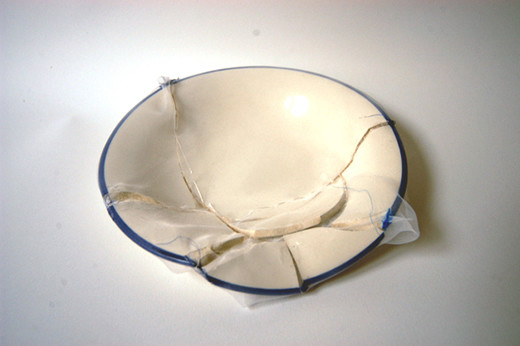Kei Takemura
01 - 29 Sep 2007

© Kei Takemura
“renovated salad dish” 2006
Japanese silk thread, Italian synthetic cloth, broken salad
dish which was used by Y.T in Berlin.
22.5 x 25 x 4 cm
“renovated salad dish” 2006
Japanese silk thread, Italian synthetic cloth, broken salad
dish which was used by Y.T in Berlin.
22.5 x 25 x 4 cm
KEI TAKEMURA
"even if we're not together"
Taka Ishii Gallery is pleased to announce our solo exhibition "even if we're not together" with Berlin-based artist Kei Takemura. This exhibition is her second solo exhibition with the gallery, and includes a new installation of four large works (100" x 127") comprised of two layers of embroidery and photograph/drawing, as well as small sculptures from the series "renovation."
I made my latest works considering as a motif people who live in parallel time with me.
The scene M.B. saw during his stay in Africa, the coast I saw in Miami.
The room of my friend R.M. who moved to Berlin after January 17th quake.
A destroyed house near my parent's house.
The scene A.F. saw when he visited his hometown, Abadan.
The scene M.H. saw when he passed through Tel Aviv.
A hundred flowers that my friend, an old German woman E.G. hand-crocheted.
I chose some of scenes from photographs given to me by people I know, scenes in which I did not participate yet touched my memory, then I overlapped my memory of other places and times to transform images. By this process, I consciously tried to make a composition of image and a selection of color which might best serve to embody memories.
For Takemura, the act of embroidery is to create a state of being "tentative." She consideres her memory through an objective practice. This state of "tentative" is embodied in her action and is based on her thought that this status equals the present state of art. She presents her works as a point of view, as means to find beauty itself and also as a prompt to consider the relationship between a point of view and an environment.
When the light falls on photographs and drawings peek through organdy, and the shadow of embroidery is layered in line, the memory of place is evoked through the image. The artist's memory does not consist of her memory but interrelated memories of an other. This traverses a border gradually* and evokes universal memories which may involve unknown people.
"even if we're not together"
Taka Ishii Gallery is pleased to announce our solo exhibition "even if we're not together" with Berlin-based artist Kei Takemura. This exhibition is her second solo exhibition with the gallery, and includes a new installation of four large works (100" x 127") comprised of two layers of embroidery and photograph/drawing, as well as small sculptures from the series "renovation."
I made my latest works considering as a motif people who live in parallel time with me.
The scene M.B. saw during his stay in Africa, the coast I saw in Miami.
The room of my friend R.M. who moved to Berlin after January 17th quake.
A destroyed house near my parent's house.
The scene A.F. saw when he visited his hometown, Abadan.
The scene M.H. saw when he passed through Tel Aviv.
A hundred flowers that my friend, an old German woman E.G. hand-crocheted.
I chose some of scenes from photographs given to me by people I know, scenes in which I did not participate yet touched my memory, then I overlapped my memory of other places and times to transform images. By this process, I consciously tried to make a composition of image and a selection of color which might best serve to embody memories.
For Takemura, the act of embroidery is to create a state of being "tentative." She consideres her memory through an objective practice. This state of "tentative" is embodied in her action and is based on her thought that this status equals the present state of art. She presents her works as a point of view, as means to find beauty itself and also as a prompt to consider the relationship between a point of view and an environment.
When the light falls on photographs and drawings peek through organdy, and the shadow of embroidery is layered in line, the memory of place is evoked through the image. The artist's memory does not consist of her memory but interrelated memories of an other. This traverses a border gradually* and evokes universal memories which may involve unknown people.
